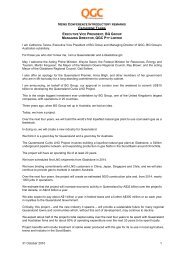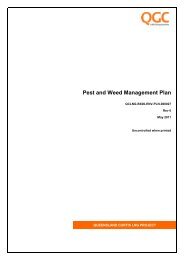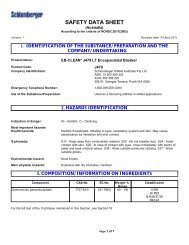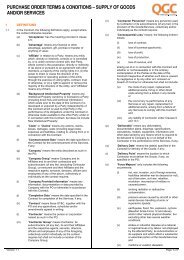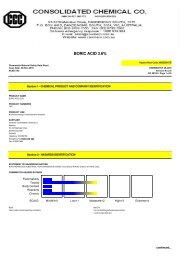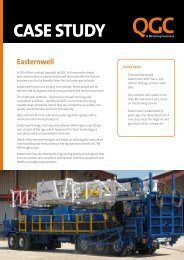Acetic Acid Glacial - QGC
Acetic Acid Glacial - QGC
Acetic Acid Glacial - QGC
- No tags were found...
You also want an ePaper? Increase the reach of your titles
YUMPU automatically turns print PDFs into web optimized ePapers that Google loves.
CG2http://jr.chemwatch.net/chemgold/msds.exe?fontsize=&print=Y&rCode=&prefname=...Page 1 of 1014/04/2009ACETIC ACID GLACIALHazard Alert Code:EXTREMEChemwatch Material Safety Data Sheet Revision No: 7 Chemwatch 2789-3Issue Date: 17-Mar-2009 CD 2009/1PRODUCT NAMEACETIC ACID GLACIALSection 1 - CHEMICAL PRODUCT AND COMPANY IDENTIFICATIONSYNONYMSC2-H4-O2, CH3COOH, ROA30, "glacial acetic acid", "acetic acid > 80%", "acetic acid vapour", "methane carboxylic acid", "vinegar acid", "ethanoic acid","ethylic acid", "anhydrous acetic acid", "pyroligneous acid", Ashland, J.T.Baker, Chem-Supply, "Fisher Scientific"PROPER SHIPPING NAMEACETIC ACID, GLACIAL or ACETIC ACID SOLUTIONPRODUCT NUMBERS10,11521,10304,10582,2871PRODUCT USEManufacturer of various acetates, acetyl compounds, acetate rayon, plastics and rubber; in tanning, printing calico and dyeing silk. As an acidulant andpreservative in foods. Solvent for many organic substances; also dissolves phosphorus, sulphur and halogen acids. Widely used in commercial organicsyntheses.SUPPLIERCompany: CONSOLIDATED CHEMICAL COAddress:52-62 Waterview CloseDANDENONG SOUTH3175Telephone: 03/9799 7555Fax: 03/9799 7666HAZARD RATINGSFlammability: 3Toxicity: 2MinMaxBody Contact: 4Reactivity: 1Chronic: 2Min/Nil=0Low=1Moderate=2High=3Extreme=4Section 2 - HAZARDS IDENTIFICATIONSTATEMENT OF HAZARDOUS NATUREHAZARDOUS SUBSTANCE. DANGEROUS GOODS. According to the Criteria of NOHSC, and the ADG Code.POISONS SCHEDULES6RISKSAFETY» Flammable. » Keep locked up.» Harmful in contact with skin. » Do not breathe gas/ fumes/ vapour/ spray.» Causes severe burns. » Avoid contact with eyes.» Risk of serious damage to eyes. » Wear suitable protective clothing.» Ingestion may produce health damage*. » To clean the floor and all objects contaminated by this material use water.» Cumulative effects may result followingexposure*.* (limited evidence).» Take off immediately all contaminated clothing.» In case of accident or if you feel unwell IMMEDIATELY contact Doctor or Poisons Information Centre(show label if possible).» This material and its container must be disposed of as hazardous waste.Section 3 - COMPOSITION / INFORMATION ON INGREDIENTSNAME CAS RN %
CG2http://jr.chemwatch.net/chemgold/msds.exe?fontsize=&print=Y&rCode=&prefname=...Page 2 of 1014/04/2009ACETIC ACID GLACIALHazard Alert Code:EXTREMEChemwatch Material Safety Data Sheet Revision No: 7 Chemwatch 2789-3Issue Date: 17-Mar-2009 CD 2009/1acetic acid glacial 64-19-7 >98Section 4 - FIRST AID MEASURESSWALLOWED» For advice, contact a Poisons Information Centre or a doctor at once. Urgent hospital treatment is likely to be needed. If swallowed do NOT induce vomiting. If vomiting occurs, lean patient forward or place on left side (head-down position, if possible) to maintain open airway and prevent aspiration. Observe the patient carefully. Never give liquid to a person showing signs of being sleepy or with reduced awareness; i.e. becoming unconscious. Give water to rinse out mouth, then provide liquid slowly and as much as casualty can comfortably drink. Transport to hospital or doctor without delay.EYE» If this product comes in contact with the eyes: Immediately hold eyelids apart and flush the eye continuously with running water. Ensure complete irrigation of the eye by keeping eyelids apart and away from eye and moving the eyelids by occasionally lifting the upper and lower lids. Continue flushing until advised to stop by the Poisons Information Centre or a doctor, or for at least 15 minutes. Transport to hospital or doctor without delay. Removal of contact lenses after an eye injury should only be undertaken by skilled personnel.SKIN» If skin or hair contact occurs: Immediately flush body and clothes with large amounts of water, using safety shower if available. Quickly remove all contaminated clothing, including footwear. Wash skin and hair with running water. Continue flushing with water until advised to stop by the Poisons Information Centre. Transport to hospital, or doctor.INHALED» If fumes or combustion products are inhaled remove from contaminated area. Lay patient down. Keep warm and rested. Prostheses such as false teeth, which may block airway, should be removed, where possible, prior to initiating first aid procedures. Apply artificial respiration if not breathing, preferably with a demand valve resuscitator, bag-valve mask device, or pocket mask as trained. Perform CPR ifnecessary. Transport to hospital, or doctor, without delay.NOTES TO PHYSICIAN» For acute or short term repeated exposures to strong acids: Airway problems may arise from laryngeal edema and inhalation exposure. Treat with 100% oxygen initially. Respiratory distress may require cricothyroidotomy if endotracheal intubation is contraindicated by excessive swelling Intravenous lines should be established immediately in all cases where there is evidence of circulatory compromise. Strong acids produce a coagulation necrosis characterised by formation of a coagulum (eschar) as a result of the dessicating action of the acid onproteins in specific tissues.INGESTION: Immediate dilution (milk or water) within 30 minutes post ingestion is recommended. DO NOT attempt to neutralise the acid since exothermic reaction may extend the corrosive injury. Be careful to avoid further vomit since re-exposure of the mucosa to the acid is harmful. Limit fluids to one or two glasses in an adult. Charcoal has no place in acid management. Some authors suggest the use of lavage within 1 hour of ingestion.SKIN: Skin lesions require copious saline irrigation. Treat chemical burns as thermal burns with non-adherent gauze and wrapping. Deep second-degree burns may benefit from topical silver sulfadiazine.EYE: Eye injuries require retraction of the eyelids to ensure thorough irrigation of the conjuctival cul-de-sacs. Irrigation should last at least 20-30 minutes. DONOT use neutralising agents or any other additives. Several litres of saline are required. Cycloplegic drops, (1% cyclopentolate for short-term use or 5% homatropine for longer term use) antibiotic drops, vasoconstrictive agents or artificialtears may be indicated dependent on the severity of the injury. Steroid eye drops should only be administered with the approval of a consulting ophthalmologist).[Ellenhorn and Barceloux: Medical Toxicology].Section 5 - FIRE FIGHTING MEASURESEXTINGUISHING MEDIA» Water spray or fog. Foam. Dry chemical powder. BCF (where regulations permit). Carbon dioxide.FIRE FIGHTING» Alert Fire Brigade and tell them location and nature of hazard. May be violently or explosively reactive. Wear full body protective clothing with breathing apparatus. Prevent, by any means available, spillage from entering drains or water courses. Consider evacuation (or protect in place). Use water delivered as a fine spray to control fire and cool adjacent area. Avoid spraying water onto liquid pools. DO NOT approach containers suspected to be hot. Cool fire exposed containers with water spray from a protected location. If safe to do so, remove containers from path of fire. Equipment should be thoroughly decontaminated after use.
CG2http://jr.chemwatch.net/chemgold/msds.exe?fontsize=&print=Y&rCode=&prefname=...Page 3 of 1014/04/2009ACETIC ACID GLACIALHazard Alert Code:EXTREMEChemwatch Material Safety Data Sheet Revision No: 7 Chemwatch 2789-3Issue Date: 17-Mar-2009 CD 2009/1FIRE/EXPLOSION HAZARD» Flammable. Moderate fire and explosion hazard when exposed to heat or flame. <strong>Acid</strong>s may react with metals to produce hydrogen, a highly flammable and explosive gas. Heating may cause expansion or decomposition leading to violent rupture of containers. May emit corrosive fumes.Combustion products include: carbon monoxide (CO), carbon dioxide (CO2), other pyrolysis products typical of burning organic material.May emit corrosive fumes.FIRE INCOMPATIBILITY» Avoid contamination with oxidising agents i.e. nitrates, oxidising acids, chlorine bleaches, pool chlorine etc. as ignition may resultHAZCHEM*2PEMERGENCY PROCEDURESSection 6 - ACCIDENTAL RELEASE MEASURESMINOR SPILLS» Remove all ignition sources. Clean up all spills immediately. Avoid breathing vapours and contact with skin and eyes. Control personal contact by using protective equipment. Contain and absorb small quantities with vermiculite or other absorbent material. Wipe up. Collect residues in a flammable waste container.MAJOR SPILLS» Chemical Class:acidic compounds, organicFor release onto land: recommended sorbents listed in order of priority.SORBENT TYPE RANK APPLICATION COLLECTION LIMITATIONSLAND SPILL - SMALLwood fiber - pillow 1 throw pitchfork R, P, DGC, RTcross-linked polymer -particulate1 shovel shovel R,W,SScross-linked polymer - pillow 1 throw pitchfork R, DGC, RTsorbent clay - particulate 2 shovel shovel R, I, Pfoamed glass - pillow 2 throw pitchfork R, P, DGC, RTwood fiber - particulate 3 shovel shovel R, W, P, DGCLAND SPILL - MEDIUMcross-linked polymer -particulate1 blower skiploader R, W, SSpolypropylene - particulate 2 blower skiploader W, SS, DGCsorbent clay - particulate 2 blower skiploader R, I, Pcross-linked polymer - pillow 3 throw skiploader R, DGC, RTpolypropylene - mat 3 throw skiploader W, SS, DGCexpanded mineral - particulate 3 blower skiploader R, I, W, P, DGCLegendDGC: Not effective where ground cover is denseR; Not reusableI: Not incinerableP: Effectiveness reduced when rainyRT:Not effective where terrain is ruggedSS: Not for use within environmentally sensitive sitesW: Effectiveness reduced when windyReference: Sorbents for Liquid Hazardous Substance Cleanup and Control;R.W Melvold et al: Pollution Technology Review No. 150: Noyes Data Corporation 1988. DO NOT touch the spill material Clear area of personnel and move upwind. Alert Fire Brigade and tell them location and nature of hazard. May be violently or explosively reactive. Wear breathing apparatus plus protective gloves. Prevent, by any means available, spillage from entering drains or water course. No smoking, naked lights or ignition sources. Increase ventilation. Stop leak if safe to do so. Water spray or fog may be used to disperse / absorb vapour. Contain spill with sand, earth or vermiculite. Use only spark-free shovels and explosion proof equipment. Collect recoverable product into labelled containers for recycling. Absorb remaining product with sand, earth or vermiculite. Collect solid residues and seal in labelled drums for disposal. Wash area and prevent runoff into drains. If contamination of drains or waterways occurs, advise emergency services.PROTECTIVE ACTIONS FOR SPILLFrom IERG (Canada/Australia)
CG2http://jr.chemwatch.net/chemgold/msds.exe?fontsize=&print=Y&rCode=&prefname=...Page 4 of 1014/04/2009ACETIC ACID GLACIALHazard Alert Code:EXTREMEChemwatch Material Safety Data Sheet Revision No: 7 Chemwatch 2789-3Issue Date: 17-Mar-2009 CD 2009/1Isolation Distance25 metresDownwind Protection Distance 250 metresIERG Number 19FOOTNOTES1 PROTECTIVE ACTION ZONE is defined as the area in which people are at risk of harmful exposure. This zone assumes that random changes in wind direction confines the vapour plume to anarea within 30 degrees on either side of the predominant wind direction, resulting in a crosswind protective action distance equal to the downwind protective action distance.2 PROTECTIVE ACTIONS should be initiated to the extent possible, beginning with those closest to the spill and working away from the site in the downwind direction. Within the protective actionzone a level of vapour concentration may exist resulting in nearly all unprotected persons becoming incapacitated and unable to take protective action and/or incurring serious or irreversible healtheffects.3 INITIAL ISOLATION ZONE is determined as an area, including upwind of the incident, within which a high probability of localised wind reversal may expose nearly all persons without appropriateprotection to life-threatening concentrations of the material.4 SMALL SPILLS involve a leaking package of 200 litres (55 US gallons) or less, such as a drum (jerrican or box with inner containers). Larger packages leaking less than 200 litres andcompressed gas leaking from a small cylinder are also considered "small spills". LARGE SPILLS involve many small leaking packages or a leaking package of greater than 200 litres, such as acargo tank, portable tank or a "one-tonne" compressed gas cylinder.5 Guide 132 is taken from the US DOT emergency response guide book.6 IERG information is derived from CANUTEC - Transport Canada.EMERGENCY RESPONSE PLANNING GUIDELINES (ERPG)The maximum airborne concentration below which it is believed that nearly all individuals could be exposed for up to one hour WITHOUT experiencing ordevelopinglife-threatening health effects is:acetic acid glacial250ppmirreversible or other serious effects or symptoms which could impair an individual's ability to take protective action is:acetic acid glacial35ppmother than mild, transient adverse effects without perceiving a clearly defined odour is:acetic acid glacial5ppmAmerican Industrial Hygiene Association (AIHA)Ingredients considered according exceed the following cutoffsVery Toxic (T+) >= 0.1% Toxic (T) >= 3.0%R50 >= 0.25% Corrosive (C) >= 5.0%R51 >= 2.5%else >= 10%where percentage is percentage of ingredient found in the mixtureSAFE STORAGE WITH OTHER CLASSIFIED CHEMICALS+ + + + X +X: Must not be stored togetherO: May be stored together with specific preventions+: May be stored togetherPersonal Protective Equipment advice is contained in Section 8 of the MSDS.Section 7 - HANDLING AND STORAGEPROCEDURE FOR HANDLING» DO NOT allow clothing wet with material to stay in contact with skinWARNING: Contact with water generates heat. Avoid all personal contact, including inhalation. Wear protective clothing when risk of exposure occurs. Use in a well-ventilated area. WARNING: To avoid violent reaction, ALWAYS add material to water and NEVER water to material. Avoid smoking, naked lights or ignition sources. Avoid contact with incompatible materials. When handling, DO NOT eat, drink or smoke. Keep containers securely sealed when not in use. Avoid physical damage to containers. Always wash hands with soap and water after handling. Work clothes should be laundered separately. Launder contaminated clothing before re-use.
CG2http://jr.chemwatch.net/chemgold/msds.exe?fontsize=&print=Y&rCode=&prefname=...Page 5 of 1014/04/2009ACETIC ACID GLACIALHazard Alert Code:EXTREMEChemwatch Material Safety Data Sheet Revision No: 7 Chemwatch 2789-3Issue Date: 17-Mar-2009 CD 2009/1 Use good occupational work practice. Observe manufacturer's storing and handling recommendations. Atmosphere should be regularly checked against established exposure standards to ensure safe working conditions are maintained. Containers, even those that have been emptied, may contain explosive vapours. Do NOT cut, drill, grind, weld or perform similar operations on or near containers.SUITABLE CONTAINER» Lined metal can. Lined metal drum. Lined metal safety cans. Packing as supplied and/or recommended by manufacturer. Plastic lining or containers may only be used if approved for flammable liquid(non-polar type). Check that containers are clearly labelled and free from leaks. DO NOT use aluminium or galvanised containersFor low viscosity materials Drums and jerricans must be of the non-removable head type. Where a can is to be used as an inner package, the can must have a screwed enclosure.For materials with a viscosity of at least 2680 cSt. (23 deg. C) and solids (between 15 C deg. and 40 deg C.): Removable head packaging; Cans with friction closures and low pressure tubes and cartridgesmay be used.-Where combination packages are used, and the inner packages are of glass, porcelain or stoneware, there must be sufficient inert cushioning material incontact with inner and outer packages unless the outer packaging is a close fitting moulded plastic box and the substances are not incompatible with theplastic. Check regularly for spills and leaks Glass container is suitable for laboratory quantities DO NOT use mild steel or galvanised containersIn accordance with ADG Code 5.9.8. Bulk transport by Road Tankers complying with construction standards RT1 or RT7STORAGE INCOMPATIBILITY» Reacts with mild steel, galvanised steel / zinc producing hydrogen gas which may form an explosive mixture with air.<strong>Acetic</strong> acid: vapours forms explosive mixtures with air (above 39 C.) reacts violently with bases such as carbonates and hydroxides (giving off large quantities of heat), oxidisers, organic amines, acetaldehyde, potassiumtert-butoxide reacts (sometimes violently), with strong acids, aliphatic amines, alkanolamines, alkylene oxides, epichlorohydrin, acetic anhydride, 2-aminoethanol,ammonia, ammonium nitrate, bromine pentafluoride, chlorosulfonic acid, chromic acid, chromium trioxide, ethylenediamine, ethyleneimine, hydrogenperoxide, isocyanates, oleum, perchloric acid, permanganates, phosphorus isocyanate, phosphorus trichloride, sodium peroxide, xylene attacks cast iron, stainless steel and other metals, forming flammable hydrogen gas attacks many forms of rubber, plastics and coatings Avoid strong bases. Segregate from alkalies, oxidising agents and chemicals readily decomposed by acids, i.e. cyanides, sulfides, carbonates.STORAGE REQUIREMENTS» Store in approved flammable liquid storage area. No smoking, naked lights/ignition sources. Keep containers securely sealed. Store away from incompatible materials in a cool, dry, well-ventilated area. Protect containers against physical damage and check regularly for leaks. Storage areas should be clearly identified, well illuminated, clear of obstruction and accessible only to trained and authorised personnel - adequatesecurity must be provided so that unauthorised personnel do not have access. Store in grounded, properly designed and approved vessels and away from incompatible materials Store according to applicable regulations for flammable materials for storage tanks, containers, piping, buildings, rooms, cabinets, allowable quantitiesand minimum storage distances. Use non-sparking ventilation systems, approved explosion proof equipment and intrinsically safe electrical systems. Have appropriate extinguishing capability in storage area (e.g. portable fire extinguishers - dry chemical, foam or carbon dioxide) and flammable gasdetectors. Keep adsorbents for leaks and spills readily available For bulk storages, consider use of floating roof or nitrogen blanketed vessels; where venting to atmosphere is possible, equip storage tank vents withflame arrestors; inspect tank vents during winter conditions for vapour/ ice build-up; storage tanks should be above ground and diked to hold entirecontents Observe manufacturer's storing and handling recommendations.EXPOSURE CONTROLSSection 8 - EXPOSURE CONTROLS / PERSONAL PROTECTIONSource Material TWA ppm TWA mg/m³ STEL ppm STEL mg/m³ Peak ppm Peak mg/m³ TWA F/CCAustralia Exposure Standards acetic acid glacial (<strong>Acetic</strong> acid) 10 25 15 37EMERGENCY EXPOSURE LIMITSMaterial Revised IDLH Value (mg/m3) Revised IDLH Value (ppm)acetic acid glacial 50MATERIAL DATA» for acetic acid:NOTE:Detector tubes for acetic acid, measuring in excess of 1 ppm, are commercially available.Exposure at or below the TLV-TWA and TLV-STEL is thought to protect the worker against conjunctival, nose and respiratory tract irritation.Odour Safety Factor(OSF)OSF=21 ("ACETIC ACID, GLACIAL").PERSONAL PROTECTION
CG2Page 8 of 10ACETIC ACID GLACIALHazard Alert Code:EXTREMEChemwatch Material Safety Data Sheet Revision No: 7 Chemwatch 2789-3Issue Date: 17-Mar-2009 CD 2009/1EYE» If applied to the eyes, this material causes severe eye damage.Direct eye contact with acid corrosives may produce pain, tears, sensitivity to light and burns. Mild burns of the epithelia generally recover rapidly andcompletely. Severe burns produce long-lasting and possibly irreversible damage. The appearance of the burn may not be apparent for several weeks afterthe initial contact. The cornea may ultimately become deeply opaque resulting in blindness.Solutions of low-molecular weight organic acids cause pain and injuryto the eyes.<strong>Acetic</strong> acid produces conjunctival irritation at concentrations below 10 ppm.SKIN» Skin contact with the material may be harmful; systemic effects may result following absorption.The material may cause moderate inflammation of the skin either following direct contact or after a delay of some time. Repeated exposure can causecontact dermatitis which is characterised by redness, swelling and blistering.Skin contact with acidic corrosives may result in pain and burns; these may be deep with distinct edges and may heal slowly with the formation of scar tissue.Action of acetic acid on the skin may be delayed and insidious.Entry into the blood-stream, through, for example, cuts, abrasions or lesions, may produce systemic injury with harmful effects. Examine the skin prior to theuse of the material and ensure that any external damage is suitably protected.INHALED» The material can cause respiratory irritation in some persons. The body's response to such irritation can cause further lung damage.Corrosive acids can cause irritation of the respiratory tract, with coughing, choking and mucous membrane damage. There may be dizziness, headache,nausea and weakness. Swelling of the lungs can occur, either immediately or after a delay; symptoms of this include chest tightness, shortness of breath,frothy phlegm and cyanosis. Lack of oxygen can cause death hours after onset.Inhalation of quantities of liquid mist may be extremely hazardous, even lethal due to spasm, extreme irritation of larynx and bronchi, chemical pneumonitisand pulmonary oedema.Minor acetic acid exposures exposure may cause transient loss of voice. A severe acute vapour exposure may cause pulmonary oedema. Exposure at 800-1200 ppm cannot be tolerated for longer than 3 minutes.CHRONIC HEALTH EFFECTS» Repeated or prolonged exposure to acids may result in the erosion of teeth, swelling and/or ulceration of mouth lining. Irritation of airways to lung, withcough, and inflammation of lung tissue often occurs. Chronic exposure may inflame the skin or conjunctiva.Long-term exposure to respiratory irritants may result in disease of the airways involving difficult breathing and related systemic problems.Substance accumulation, in the human body, may occur and may cause some concern following repeated or long-term occupational exposure.Repeated minor oral exposure to acetic acid can cause blackening of the skin and teeth, erosion of the teeth, vomiting, diarrhoea, nausea. Repeated minorvapour exposure may cause chronic respiratory inflammation and bronchitis.It is reported that workers exposed for 7 to 12 years at concentrations of 60 ppm acetic acid, plus one hour daily at 100-260 ppm had no injury except slightirritation of the respiratory tract, stomach, and skin although this report is equivocal as in another study different researchers found conjunctivitis, bronchitis,pharyngitis and erosion of exposed teeth apparently in the same workers.Occupational exposures for 7-12 years to concentrations of 80-200 ppm, at peaks, caused blackening and hyperkeratosis of the skin and hands,conjunctivitis (but no corneal damage), bronchitis and pharyngitis and erosion of the exposed teeth (incisors and canines). Digestive disorders with heartburnand constipation have been reported at unspecified prolonged exposures.TOXICITY AND IRRITATION» unless otherwise specified data extracted from RTECS - Register of Toxic Effects of Chemical Substances.TOXICITYIRRITATIONOral (human) TDLo: 1.47 mg/kgUnreport (man) LDLo: 308 mg/kgOral (rat) LD50: 3310 mg/kgSkin (human):50mg/24hr - MildSkin (rabbit):525mg (open)-SEVEREEye (rabbit): 0.05mg (open)-SEVEREInhalation (human) TCLo: 816 ppm/3 minInhalation (rat) LCLo: 16000 ppm/4 hrDermal (rabbit) LD50: 1060 mg/kg» Asthma-like symptoms may continue for months or even years after exposure to the material ceases. This may be due to a non-allergenic condition knownas reactive airways dysfunction syndrome (RADS) which can occur following exposure to high levels of highly irritating compound. Key criteria for thediagnosis of RADS include the absence of preceding respiratory disease, in a non-atopic individual, with abrupt onset of persistent asthma-like symptomswithin minutes to hours of a documented exposure to the irritant. A reversible airflow pattern, on spirometry, with the presence of moderate to severebronchial hyperreactivity on methacholine challenge testing and the lack of minimal lymphocytic inflammation, without eosinophilia, have also been includedin the criteria for diagnosis of RADS. RADS (or asthma) following an irritating inhalation is an infrequent disorder with rates related to the concentration ofand duration of exposure to the irritating substance. Industrial bronchitis, on the other hand, is a disorder that occurs as result of exposure due to highconcentrations of irritating substance (often particulate in nature) and is completely reversible after exposure ceases. The disorder is characterised bydyspnea, cough and mucus production.The material may produce severe irritation to the eye causing pronounced inflammation. Repeated or prolonged exposure to irritants may produceconjunctivitis.The material may cause severe skin irritation after prolonged or repeated exposure and may produce on contact skin redness, swelling, the production ofvesicles, scaling and thickening of the skin. Repeated exposures may produce severe ulceration.NOAELs following repeated exposure to acetic acid and its salts range from 210 mg/kg bw/day (2-4 month acetic acid drinking water study; systemic toxicity)to 3600 mg/kg bw/day (acetic acid, sodium salt, 4 week dietary study; no effects reported). Signs of irritation/corrosion at the site of contact as well assystemic toxicity have been reported. Prolonged inhalation exposure to acetic acid results in muscle imbalance, increase in blood cholinesterase activity,decreases in albumins and decreased growth at concentrations greater than 0.01 mg/m3/day.Groups of 20 mice/sex were given 0.025% sodium acetate in drinking water (about 60 mg/kg bw/day) for 1 week before breeding, during a 9-day breedingperiod and (females only) throughout pregnancy, lactation and until the offspring were weaned at 3 weeks of age. No effects on fertility were observed. Themale offspring were given the same solution until they were 5-7 weeks old and were then examined in a 24-hour activity test. Examination of the littersrevealed no overt deformities and normal pup weights at day 1 and day 21. The activity of offspring of the treated group was lower than that of controlsduring the first 12 hours but was similar during the second 12 hours. It is unknown if the decreased activity observed in the sodium acetate treated group towas a result of exposure in utero and/or post-weaning, since the pups were exposed during both time periods.). <strong>Acetic</strong> acid had no effects on implantation oron maternal or fetal survival in rats, mice or rabbits dosed via gavage during gestation days 6-19 at doses up to 1600 mg/kg/day. The number ofabnormalities seen in either soft or skeletal tissues of the test groups did not differ from the number occurring in the controls. Sodium acetate had no effecton pregnant mice or offspring when mice were administered 1000 mg/kg bw, by gavage on days 8-12 of gestation.Section 12 - ECOLOGICAL INFORMATION» Fish LC50 (96hr.) (mg/l): 88, 92» Daphnia magna EC50 (48hr.) (mg/l): 32» Algae IC50 (72hr.) (mg/l): 90» log Kow (Prager 1995): - 0.31» log Kow (Sangster 1997): - 0.17» log Pow (Verschueren 1983): 1.8E+0» <strong>Acetic</strong> acid and its salts (the acetates) can be grouped together because of their close structural relationships, their natural occurrence in plants andhttp://jr.chemwatch.net/chemgold/msds.exe?fontsize=&print=Y&rCode=&prefname=...14/04/2009
CG2http://jr.chemwatch.net/chemgold/msds.exe?fontsize=&print=Y&rCode=&prefname=...Page 9 of 1014/04/2009ACETIC ACID GLACIALHazard Alert Code:EXTREMEChemwatch Material Safety Data Sheet Revision No: 7 Chemwatch 2789-3Issue Date: 17-Mar-2009 CD 2009/1animals, and their fundamental role in cell metabolism, particularly in the tricarboxylic acid cycle (also known as the citric acid or Kreb’s cycle), which iswhere humans get their energy. <strong>Acetic</strong> acid is degraded photochemically in the atmosphere to produce hydroxyl radicals (estimated typical half-life of 22 days). Physical removal ofacetates on atmospheric particulates may occur via wet or dry deposition. Natural water will neutralise dilute solutions of acetic acid. Spills of acetic acid on soil will readily biodegrade - the biodegradation rate for acetic acid after 14 days under aerobic conditions is 74 days. In invertebrates the toxicity of acetic acid (EC50 = 50-450 mg/L, depending on test species) -under static conditions, the 48 hour EC50 value for aceticacid is 65 mg/L for aquatic invertebrates (the test media was not neutralised). When the test solutions are neutralised, to form acetates, the static 48 hourEC50 for acetic acid is 6000 mg/L. In renewal systems with aquatic invertebrates, 48 hour EC50s for acetic acid are 100 mg/L and 180 mg/L. Fish LC50 (96 h): 75-88 mg/l. <strong>Acetic</strong> acid is not expected to bioconcentrate in the aquatic system. Low concentrations of acetic acid are harmful to fish. Drinking water standards: none available. Soil Guidelines: none available. Air Quality Standards: none available» Prevent, by any means available, spillage from entering drains or water courses.» DO NOT discharge into sewer or waterways.Section 13 - DISPOSAL CONSIDERATIONS» Containers may still present a chemical hazard/ danger when empty. Return to supplier for reuse/ recycling if possible.Otherwise: If container can not be cleaned sufficiently well to ensure that residuals do not remain or if the container cannot be used to store the same product, thenpuncture containers, to prevent re-use, and bury at an authorised landfill. Where possible retain label warnings and MSDS and observe all notices pertaining to the product.Legislation addressing waste disposal requirements may differ by country, state and/ or territory. Each user must refer to laws operating in their area. Insome areas, certain wastes must be tracked.A Hierarchy of Controls seems to be common - the user should investigate: Reduction, Reuse Recycling Disposal (if all else fails)This material may be recycled if unused, or if it has not been contaminated so as to make it unsuitable for its intended use. If it has been contaminated, itmay be possible to reclaim the product by filtration, distillation or some other means. Shelf life considerations should also be applied in making decisions ofthis type. Note that properties of a material may change in use, and recycling or reuse may not always be appropriate. DO NOT allow wash water from cleaning or process equipment to enter drains. It may be necessary to collect all wash water for treatment before disposal. In all cases disposal to sewer may be subject to local laws and regulations and these should be considered first. Where in doubt contact the responsible authority. Recycle wherever possible. Consult manufacturer for recycling options or consult local or regional waste management authority for disposal if no suitable treatment or disposal facilitycan be identified. Treat and neutralise at an approved treatment plant. Treatment should involve: Neutralisation with soda-ash or soda-lime followed by: Burial in a licencedland-fill or Incineration in a licenced apparatus Decontaminate empty containers with 5% aqueous sodium hydroxide or soda ash, followed by water. Observe all label safeguards until containers arecleaned and destroyed.Section 14 - TRANSPORTATION INFORMATIONLabels Required: CORROSIVE,FLAMMABLE LIQUIDHAZCHEM: 2P (ADG6)Land Transport UNDG:Class or division: 8 Subsidiary risk: 3UN No.: 2789 UN packing group: IIShipping Name:ACETIC ACID, GLACIAL or ACETIC ACID SOLUTION more than80% acid, by massAir Transport IATA:ICAO/IATA Class: 8 ICAO/IATA Subrisk: 3UN/ID Number: 2789 Packing Group: IISpecial provisions:NoneShipping Name: ACETIC ACID, GLACIALMaritime Transport IMDG:IMDG Class: 8 IMDG Subrisk: 3UN Number: 2789 Packing Group: IIEMS Number: F-E,S-C Special provisions: NoneLimited Quantities:1 LShipping Name: ACETIC ACID, GLACIAL or ACETIC ACID SOLUTION,more than 80% acid, by mass
CG2http://jr.chemwatch.net/chemgold/msds.exe?fontsize=&print=Y&rCode=&prefname=...Page 10 of 1014/04/2009ACETIC ACID GLACIALHazard Alert Code:EXTREMEChemwatch Material Safety Data Sheet Revision No: 7 Chemwatch 2789-3Issue Date: 17-Mar-2009 CD 2009/1POISONS SCHEDULES6Section 15 - REGULATORY INFORMATIONREGULATIONSacetic acid glacial (CAS: 64- 19- 7) is found on the following regulatory lists;Australia Exposure StandardsAustralia Hazardous SubstancesAustralia High Volume Industrial Chemical List (HVICL)Australia Illicit Drug Reagents/Essential Chemicals - Category IIIAustralia Inventory of Chemical Substances (AICS)Australia National Pollutant InventoryAustralia Standard for the Uniform Scheduling of Drugs and Poisons (SUSDP) - Appendix E (Part 2)Australia Standard for the Uniform Scheduling of Drugs and Poisons (SUSDP) - Appendix F (Part 3)Australia Standard for the Uniform Scheduling of Drugs and Poisons (SUSDP) - Schedule 2Australia Standard for the Uniform Scheduling of Drugs and Poisons (SUSDP) - Schedule 5Australia Standard for the Uniform Scheduling of Drugs and Poisons (SUSDP) - Schedule 6CODEX General Standard for Food Additives (GSFA) - Additives Permitted for Use in Food in General, Unless OtherwiseSpecified, in Accordance with GMPGESAMP/EHS Composite List of Hazard Profiles - Hazard evaluation of substances transported by shipsIMO IBC Code Chapter 17: Summary of minimum requirementsIMO MARPOL 73/78 (Annex II) - List of Noxious Liquid Substances Carried in BulkIMO Provisional Categorization of Liquid Substances - List 1: Pure or technically pure productsInternational Council of Chemical Associations (ICCA) - High Production Volume ListOECD Representative List of High Production Volume (HPV) ChemicalsSection 16 - OTHER INFORMATION» Classification of the preparation and its individual components has drawn on official and authoritative sources as well as independent review by theChemwatch Classification committee using available literature references.A list of reference resources used to assist the committee may be found at:www.chemwatch.net/references.» The (M)SDS is a Hazard Communication tool and should be used to assist in the Risk Assessment. Many factors determine whether the reported Hazardsare Risks in the workplace or other settings. Risks may be determined by reference to Exposures Scenarios. Scale of use, frequency of use and current oravailable engineering controls must be considered.This document is copyright. Apart from any fair dealing for the purposes of private study, research, review or criticism, aspermitted under the Copyright Act, no part may be reproduced by any process without written permission from CHEMWATCH.TEL (+61 3) 9572 4700.Issue Date: 17-Mar-2009Print Date:14-Apr-2009



